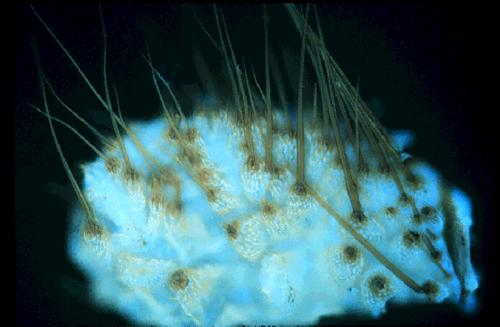Scientists from the Institute of Organic Chemistry and Biochemistry in Prague, Czech Republic, and the Max Planck Institute for Chemical Ecology in Jena, Germany, studied the pheromone chemistry of moths and discovered a new evolutionary mechanism: A single amino acid residue in desaturases − enzymes that introduce double bonds, of the tobacco hornworm Manduca sexta − switches the desaturase products from mono- and di-unsaturated to tri-unsaturated sex pheromone precursors. The susceptibility of desaturases to major shifts in their specificities, due to minor mutations, may significantly contribute to the divergence in moth pheromone communication and so lead to the evolution of new insect species (Proceedings of the National Academy of Sciences of the United States of America, October 2015).
Sex pheromones represent a diverse group of chemical compounds which are central to mate-finding behavior in insects and can be found across various life forms. In most moth species, females use species-specific sex pheromones consisting of volatile fatty acid derivatives to attract conspecific males over long distances. These pheromones are predominantly long-chain aliphatic acetates, alcohols, or aldehydes containing up to three carbon-carbon double bonds with variable configurations at various positions along the carbon backbone. Pheromone-biosynthetic fatty acid desaturases, enzymes that introduce double bonds at specific positions and configurations into fatty acyl pheromone precursors of various chain lengths, contribute significantly to the number of possible pheromone structures. To maintain an efficient chemical communication, the signal receiver must stay tuned to the signal producer: This means that the pheromone composition and the pheromone preference should be inter-coordinated and therefore not undergo any changes. Since traits underlying pheromone production and the underlying preference for particular pheromone are probably not genetically linked to each other, changes in pheromone communication at either side were expected to be discoordinate and thus to be strongly selected against.

An international team of chemists, biochemists, molecular biologists and bioinformatics specialists from the Max Planck Institute for Chemical Ecology in Jena and the Institute of Organic Chemistry and Biochemistry of the Czech Academy of Sciences in Prague used the tobacco hornworm Manduca sexta as a model organism for the elucidation of molecular and evolutionary mechanisms underlying the acquisition of novel pheromone components. The Manduca sexta female pheromone contains unique conjugated tri-unsaturated conjugated aldehydes; these aldehydes are essential for a full range of mating responses in Manduca sexta males.
The researchers discovered an important pathway leading to an abrupt change in pheromone compositions which is caused by a tiny alteration: Isoleucine is replaced by alanine amino acids at the position 224 in the MsexD2 desaturase. The specificity of MsexD2 for producing conjugated dienes was changed to the MsexD3 specificity for producing conjugated trienes. By swapping the two amino acids at this position in these desaturases, their specificity was interconverted. The first desaturase is present in related silkworm females (Bombyx mori); duplication and mutation of this desaturase could responsible for the development of these two species from a common ancestor approximately 12 million years ago.
"We were surprised of how well our findings match with the recently published structure of CoA-fatty acid desaturases; the position 224 is in the proper place of the channel in the desaturases positioning the fatty acid chain for the desaturation event," Aleš Buček, first author of the publication, pointed out. In addition to these two desaturases, another five transcripts were further studied and functionally characterized, demonstrating the complexity of pheromone biosynthesis in Manduca sexta females.
"This is an intriguing story which started in 1997 when Iva Pichová and I decided to work on this project during lunch. But only recently and by use of next-generation sequencing techniques and other modern analytical instrumentation were we able to make this project a success," said Aleš Svatoš, who heads the research group Mass Spectrometry and Proteomics at the Max Planck Institute and is closely cooperating with his home institute in Prague. "Now we have all tools available to confirm and refine our findings in other members of the Bombycoidea family," concluded Iva Pichová.




Comments